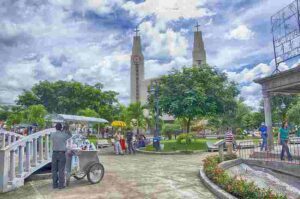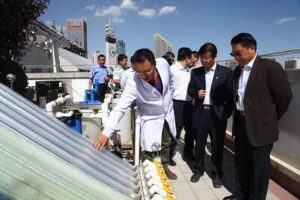5 Examples of Green Economy Explained
Examples of green economy are; decarbonized production in Denmark, Costa Rican tourism, organic agriculture in India, renewable energy development in China, and Switzerland’s sustainable policy-driven economy.
This article discusses the examples of green economy, as follows;
1). Decarbonized Production in Denmark (as one of the Examples of Green Economy)
Denmark is viewed as one of the global leaders in economic decarbonization [2].
Efforts by the Danish Government to reduce carbon emissions have been spearheaded by the Danish Ministry of Climate Energy and Utilities, among other organizational bodies; and these efforts include the adoption of alternative (clean) energy resources, sustainable technologies, and manufacturing approaches, green building development, and raw material selection.
These efforts collectively aim to mitigate climate change and achieve net-zero carbon emissions by 2050, in line with the sustainable development agenda.
Policy development and implementation have been important tools in the green economic development of Denmark.
Since 1990, Denmark has reduced its GDP-based emissions of greenhouse gases by approximately 50%; and hopes to increase this emissions-cut to 70% by 2030 [1].
A major aspect of the green economic scheme of Denmark is occupied by renewable energy, so that the energy transition in this country is fast-paced compared to others.
Circular economic practices are also implemented to prevent resource depletion; including recycling and conservative production, while sustainable consumption is an objective in progress through policy-driven, concerted efforts by stakeholders in various sectors of the economy.
2). Costa Rican Tourism Sectorial Economy
The tourism sector of Costa Rica occupies a prominent part of the country’s economy, accounting for 10.8% and 5.0% of the total GDP in 2019 and 2020 respectively [3].
Job creation is also active in the sector, with hundreds of thousands of jobs created annually.
In line with this, major efforts have been, and are being, made to protect the natural ecosystems of Costa Rica.
These efforts are backed by environmental protection schemes and policies, that are geared toward tailoring economic practices to meet ecologic needs.
Although Costa Rica is not a leader in clean energy development, sustainable agriculture, conservative resource consumption and manufacturing are all encouraged as part of economic approaches to mitigate environmental impacts while meeting the needs of the human population.

3). Organic Agricultural Economy, India (as one of the Examples of Green Economy)
India’s organic agricultural economy is one of the largest in the world, with over 2 million hectares of land being actively used for organic farming [5].
In addition to its role in revenue generation and job creation, the organic agricultural sector of India has an effect on its overall economy, as it encourages sustainability in the selection of production materials and methods, as well as in the consumption of finished products.
As a sector, the cycle of production and consumption of organic foods constitutes a green economic dynamic, because it does not involve significant input of any element that can cause environmental degradation.
4). Renewable Energy Development in China
As of 2022, China is leading the way in renewable energy development on a global scale, as a result of multiple projects in solar and wind energy technology.
The amount by percentage of China’s energy that is renewable as of 2022 is nearly 45% [6].
As a global leader in renewable energy, the economy of China has been significantly impacted by energy transition efforts in the country.
Many Chinese industrial and commercial processes rely at least partly on renewable energy, meaning that the production-consumption cycle can be said to be significantly decarbonized.
Economic benefits of renewable energy development in China include cost savings, energy conservation and efficiency of processes, less energy wastage, and lower expenditure on environmental remediation.

5). Switzerland’s Sustainable Policy-driven Economy (as one of the Examples of Green Economy)
Switzerland ranks highly as one of the leading green economies of the world.
The sustainability and economic success of this country can be attributed directly to major investment in renewable energy; in the form of solar, geothermal, wind and hydro.
Hydroelectricity is a particularly dominant form of renewable power in Switzerland, as a result of significant availability of water resources [4].
A green economic model has also made it possible to achieve low unemployment rates and high productivity compared to other countries.
Conclusion
Examples of green economy are;
1. Decarbonized Production in Denmark
2. Costa Rican Tourism Sectorial Economy
3. Organic Agricultural Economy, India
4. Renewable Energy Development in China
5. Switzerland’s Sustainable Policy-driven Economy
References
1). Batini, N.; Parry, I. W. H.; Wingender, P. (2020). “Climate Mitigation Policy in Denmark: A Prototype for Other Countries.” Available at: https://www.imf.org/en/Publications/WP/Issues/2020/11/12/Climate-Mitigation-Policy-in-Denmark-A-Prototype-for-Other-Countries-49882. (Accessed 23 December 2022).
2). Çağatay, G. (2017). “Denmark remains global leader in decarbonization: IEA.“ Available at: https://www.aa.com.tr/en/energy/wind/denmark-remains-global-leader-in-decarbonization-iea/14755. (Accessed 23 December 2022).
3). López, A. M. (2022). “Tourism share of GDP in Costa Rica 2019-2021.” Available at: https://www.statista.com/statistics/873744/costal-rica-travel-tourism-breakdown-contribution-to-gdp/. (Accessed 23 December 2022).
4). Manso, P.; Scahefli, B.; Schleiss, A. J. (2015). “Adaptation of Swiss hydropower infrastructure to meet future electricity needs.” Hydro 2015, Bordeaux, France. Available at: https://www.semanticscholar.org/paper/Adaptation-of-Swiss-hydropower-infrastructure-to-Manso-Schaefli/bca45104ce97a651517452817d420087eee3545e. (Accessed 23 December 2022).
5). Nelson, A. E.; Ravichandran, K.; Antony, U. (2019). “The impact of the Green Revolution on indigenous crops of India.” Journal of Ethnic Foods 6(1):8. Available at: https://doi.org/10.1186/s42779-019-0011-9. (Accessed 23 December 2022).
6). Xue, Y. (2022). “China to remain renewable energy leader with strong capacity growth in 2022, despite subsidies phase-out.” Available at: https://www.scmp.com/business/china-business/article/3161732/china-remain-renewable-energy-leader-strong-capacity-growth. (Accessed 20 December 2022).

